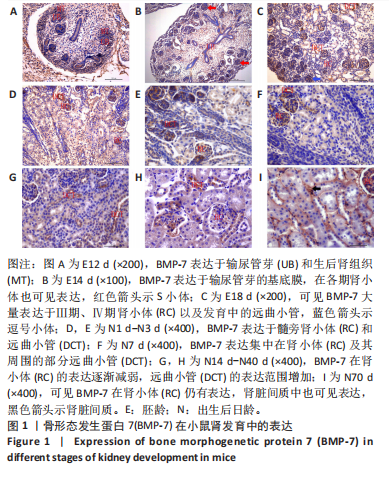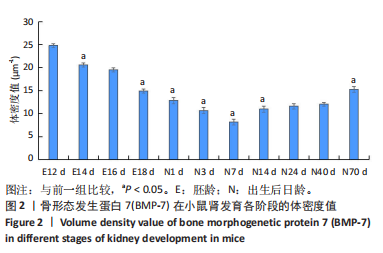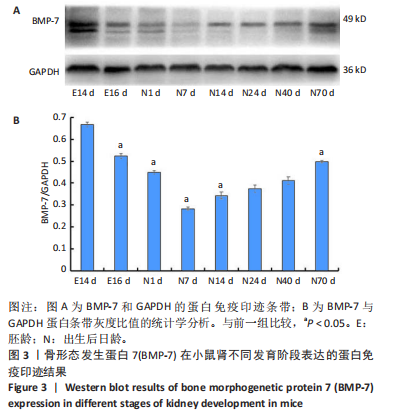[1] XIAO Y, LIANG D, LI Z, et al. BMP-7 Upregulates Id2 Through the MAPK Signaling Pathway to Improve Diabetic Tubulointerstitial Fibrosis and the Intervention of Oxymatrine. Front Pharmacol. 2022;13:900346.
[2] CHEN Y, RUI R, WANG L, et al. Huangqi decoction ameliorates kidney injury in db/db mice by regulating the BMP/Smad signaling pathway. BMC Complement Med Ther. 2023;23(1):209.
[3] KUBILIUTE R, ZALIMAS A, BAKAVICIUS A, et al. Clinical Significance of ADAMTS19, BMP7, SIM1, and SFRP1 Promoter Methylation in Renal Clear Cell Carcinoma. Onco Targets Ther. 2021;14:4979-4990.
[4] LIANG C, LIANG Q, XU X, et al. Bone morphogenetic protein 7 mediates stem cells migration and angiogenesis: therapeutic potential for endogenous pulp regeneration. Int J Oral Sci. 2022; 14(1):38.
[5] TSUJIMOTO H, ARAOKA T, NISHI Y, et al. Small molecule TCS21311 can replace BMP7 and facilitate cell proliferation in in vitro expansion culture of nephron progenitor cells. Biochem Biophys Res Commun. 2021;558:231-238.
[6] SMITH C, DU TOIT R, OLLEWAGEN T. Potential of bone morphogenetic protein-7 in treatment of lupus nephritis: addressing the hurdles to implementation. Inflammopharmacology. 2023;31(5):2161-2172.
[7] MALINAUSKAS T, MOORE G, RUDOLF AF, et al. Molecular mechanism of BMP signal control by Twisted gastrulation. Nat Commun. 2024; 15(1):4976.
[8] SCHNELL J, ACHIENG M, LINDSTRÖM NO. Principles of human and mouse nephron development. Nat Rev Nephrol. 2022;18(10):
628-642.
[9] 李静姝,王莹.510例小儿肾病综合征激素耐药调查及其影响因素分析[J].公共卫生与预防医学,2024,35(4):79-82.
[10] 王艳珍.低分子肝素钙注射液与泼尼松联合治疗用于小儿肾病综合征临床效果研究[J].医药论坛杂志,2024,45(3):307-310.
[11] KONG L, WANG H, LI C, et al. Sulforaphane Ameliorates Diabetes-Induced Renal Fibrosis through Epigenetic Up-Regulation of BMP-7. Diabetes Metab J. 2021;45(6):909-920.
[12] LI X, YUE W, FENG G, et al. Uterine Sensitization-Associated Gene-1 in the Progression of Kidney Diseases. J Immunol Res. 2021;2021: 9752139.
[13] MANZANO-LISTA FJ, SANZ-GÓMEZ M, GONZÁLEZ-MORENO D, et al. Imbalance in Bone Morphogenic Proteins 2 and 7 Is Associated with Renal and Cardiovascular Damage in Chronic Kidney Disease. Int J Mol Sci. 2022;24(1):40.
[14] LEE CT, KUO WH, TAIN YL, et al. Exogenous BMP7 administration attenuated vascular calcification and improved bone disorders in chronic uremic rats. Biochem Biophys Res Commun. 2022;621:8-13.
[15] CARLSON WD, KECK PC, BOSUKONDA D, et al. A Process for the Design and Development of Novel Bone Morphogenetic Protein-7 (BMP-7) Mimetics With an Example: THR-184. Front Pharmacol. 2022;13:864509.
[16] LIU W, GU R, LOU Y, et al. Emodin-induced autophagic cell death hinders epithelial-mesenchymal transition via regulation of BMP-7/TGF-β1 in renal fibrosis. J Pharmacol Sci. 2021;146(4):216-225.
[17] 薄双玲,马太芳,白慧健,等.成纤维细胞生长因子受体1,2在小鼠肾发育中的动态表达[J].中国组织工程研究,2024,28(25):4018-4021.
[18] BONGIOVANNI C, BUENO-LEVY H, POSADAS PENA D, et al. BMP7 promotes cardiomyocyte regeneration in zebrafish and adult mice. Cell Rep. 2024;43(5):114162.
[19] BAI Y, CUI G, SUN X, et al. ANGPTL4 Stabilizes Bone Morphogenetic Protein 7 Through Deubiquitination and Promotes HCC Proliferation via the SMAD/MAPK Pathway. DNA Cell Biol. 2024; 43(8):395-400.
[20] HUYUT Z, BAKAN N, YILDIRIM S, et al. Can zaprinast and avanafil induce the levels of angiogenesis, bone morphogenic protein 2, 4 and 7 in kidney of ovariectomised rats? Arch Physiol Biochem. 2022;128(4): 945-950.
[21] RAMING R, CORDASIC N, KIRCHNER P, et al. Neonatal nephron loss during active nephrogenesis results in altered expression of renal developmental genes and markers of kidney injury. Physiol Genomics. 2021;53(12):509-517.
[22] TAKANO M, TODA S, WATANABE H, et al. Engineering of a Long-Acting Bone Morphogenetic Protein-7 by Fusion with Albumin for the Treatment of Renal Injury. Pharmaceutics. 2022;14(7):1334.
[23] DUDLEY AT, LYONS KM, ROBERTSON EJ. A requirement for bone morphogenetic protein-7 during development of the mammalian kidney and eye. Genes Dev. 1995;9(22):2795-2807.
[24] LUO G, HOFMANN C, BRONCKERS AL, et al. BMP-7 is an inducer of nephrogenesis, and is also required for eye development and skeletal patterning. Genes Dev. 1995;9(22):2808-2820.
[25] BEJOY J, FARRY JM, PEEK JL, et al. Podocytes derived from human induced pluripotent stem cells: characterization, comparison, and modeling of diabetic kidney disease. Stem Cell Res Ther. 2022; 13(1):355.
[26] PENG W, ZHOU X, XU T, et al. BMP-7 ameliorates partial epithelial-mesenchymal transition by restoring SnoN protein level via Smad1/5 pathway in diabetic kidney disease. Cell Death Dis. 2022;13(3):254.
[27] 刘星辰,王璟,刘博阳,等.PTH缺失通过诱导肾脏细胞衰老和衰老相关分泌表型分子表达而加速肾脏纤维化[J].现代生物医学进展,2024,24(16):3006-3012.
[28] 焦楠,张蕊.EUK134对衰老相关肾脏纤维化的作用[J].实用医技 杂志,2023,30(8):602-604.
[29] MOHAMMADI Y, ZANGOOEI M, SALMANI F, et al. Effect of crocin and losartan on biochemical parameters and genes expression of FRMD3 and BMP7 in diabetic rats. Turk J Med Sci. 2023;53(1):10-18.
[30] ZEDER K, SIEW ED, KOVACS G, et al. Pulmonary hypertension and chronic kidney disease: prevalence, pathophysiology and outcomes. Nat Rev Nephrol. 2024;20(11):742-754.
[31] LU Y, FOG-POULSEN K, NØRREGAARD R, et al. Gender-dependent bladder response to one-day bladder outlet obstruction. J Pediatr Urol. 2021;17(2):170.e1-170.e10.
[32] TAGLIENTI M, GRAF D, SCHUMACHER V, et al. Bmp7 drives proximal tubule expansion and determines nephron number in the developing kidney. Development. 2022;149(14):dev200773.
[33] KORBUT AI, ROMANOV VV, KLIMONTOV VV. Urinary Markers of Tubular Injury and Renal Fibrosis in Patients with Type 2 Diabetes and Different Phenotypes of Chronic Kidney Disease. Life (Basel). 2023;13(2):343.
[34] LI J, YU C, SHEN F, et al. Class IIa histone deacetylase inhibition ameliorates acute kidney injury by suppressing renal tubular cell apoptosis and enhancing autophagy and proliferation. Front Pharmacol. 2022;13:946192.
[35] SONG SH, HAN D, PARK K, et al. Bone morphogenetic protein-7 attenuates pancreatic damage under diabetic conditions and prevents progression to diabetic nephropathy via inhibition of ferroptosis. Front Endocrinol (Lausanne). 2023;14:1172199.
[36] 毛小英,谭忠华,孙春锋.血清BMP-7与99mTc-DTPA肾动态显像在糖尿病肾病中的相关性研究[J].南京医科大学学报(自然科学版),2020,40(1):96-99+103.
[37] 朱虹,赵贵辛,刘铁奇,等.血清骨形态发生蛋白-7与2型糖尿病肾病病变程度的临床研究[J].中华临床医师杂志(电子版), 2014,8(9):1615-1619.
[38] VUKICEVIC S, BASIC V, ROGIC D, et al. Osteogenic protein-1 (bone morphogenetic protein-7) reduces severity of injury after ischemic acute renal failure in rat. J Clin Invest. 1998;102(1):202-214.
[39] YEH LC, ADAMO ML, OLSON MS, et al. Osteogenic protein-1 and insulin-like growth factor I synergistically stimulate rat osteoblastic cell differentiation and proliferation. Endocrinology. 1997;138(10):4181-4190.
[40] SREEKUMAR V, ASPERA-WERZ RH, TENDULKAR G, et al. BMP9 a possible alternative drug for the recently withdrawn BMP7? New perspectives for (re-)implementation by personalized medicine. Arch Toxicol. 2017;91(3):1353-1366.
|


